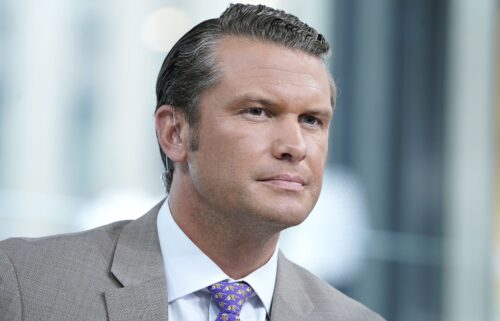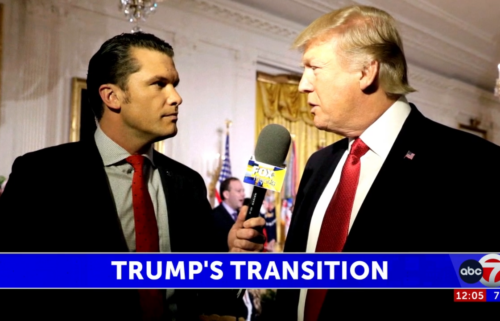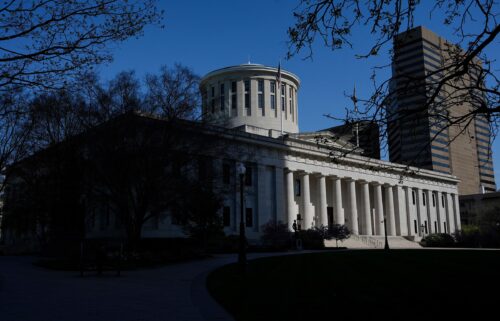Fact check: Trump makes at least 21 false claims at NATO meetings

President Donald Trump held official meetings with two foreign leaders and the head of NATO at the alliance summit in London on Tuesday — and turned the public portion of each of the three sessions into his own highly dishonest impromptu press conference.
Trump treated NATO Secretary General Jens Stoltenberg, French President Emmanuel Macron and Canadian Prime Minister Justin Trudeau to a selection of his favorite fictions, most of which we have fact-checked before, and sprinkled in some new nonsense for good measure.
Speaking to reporters for more than two hours in total, Trump made at least 21 false claims. That’s our initial count. The total may well grow once we have time to do some deeper fact-checking.
Embarking on a dishonesty blitz while at a foreign summit would be strange behavior for any other president. For Trump, long impervious to norms of propriety and accuracy, it was just another Tuesday.
Trump made false claims about NATO while sitting with Stoltenberg, and false claims about Europe while sitting with Macron. Both know the truth — and Macron fact-checked one of Trump’s claims to his face. But Trump was, as ever, undeterred. He has been as reliably inaccurate when speaking to knowledgeable officials as he is when directly addressing average citizens.
Our list of 21 false claims doesn’t include some misleading, dubious or questionable claims Trump made about NATO and US foreign relations.
Trump repeatedly said, for example, that NATO members are “delinquent” for failing to meet the alliance’s guideline of having each member spend 2% of their Gross Domestic Product on defense. The guideline does not impose binding financial obligations or debts, and NATO’s 2014 agreement says that members will work to meet the target within a decade, not that they must hit it immediately.
Here’s the list:
NATO and the military
Military spending by NATO members
Trump said with Stoltenberg that military spending by NATO members “was going down for close to 20 years. If you look at a chart, it was like a rollercoaster down, nothing up.” And he said with Macron that NATO “was really heading in the wrong direction three years ago — it was heading down. If you look at a graph, it was to a point where I don’t think they could have gone on much longer.”
Facts First: Military spending by NATO members had increased for two years prior to Trump’s presidency. According to official NATO figures, spending increased by 1.8% in 2015 and 2.8% in 2016.
US military spending
Trump said that while Germany is spending a mere 1% to 1.2% of its GDP on defense, the US is spending “4 to 4.3%.”
Facts First: The US is expected to spend 3.42% of GDP on defense in 2019, according to NATO estimates issued in June, similar to its 2018 level.
Progress against ISIS
Trump claimed that ISIS still possessed “virtually 100%” of its so-called “caliphate” when he took office, “and I knocked it down to 0.”
Facts First: A substantial portion of ISIS territory had been retaken by the time Trump was inaugurated in 2017.
“President Trump’s statement is inaccurate because at the time of his inauguration in January 2017, the Obama administration had regained close to 50% of ISIS’s would-be Caliphate,” Nicholas Heras, Middle East security fellow at the Center for a New American Security, said in response to a previous version of this Trump claim.
Estimates of pre-Trump progress against ISIS vary, but Heras’ estimate roughly squares with reports from the end of the Obama era. Regardless of the precise figure, there is no doubt that ISIS had lost a big chunk of its former territory by the time Trump was inaugurated.
Ammunition
Trump said that when he took office, the US military “was in trouble.” He added, “We didn’t have ammunition.”
Facts First: According to military leaders, there was a shortfall in certain kinds of munitions, particularly precision-guided bombs, late in the Obama presidency and early in the Trump presidency. But the claim that “we didn’t have ammunition” is a significant exaggeration. Military leaders did not say that they had completely run out of any kind of bomb, let alone ammunition in general.
You can read a full fact check of Trump’s claims about munitions levels here.
ISIS prisoners
Trump said of ISIS prisoners in Syria: “But many are from France, many are from Germany, many are from UK. They’re mostly from Europe.”
Facts First: Macron correctly told Trump that it is not true that “most” ISIS prisoners in Syria are from Europe.
James Jeffrey, Trump’s special envoy to the anti-ISIS coalition, said on August 1 that roughly 8,000 of about 10,000 terrorist fighters being held in northeastern Syria are Iraqi or Syrian nationals; there were “about 2,000 ISIS foreign fighters” from all other countries. Trump himself tweeted in February to ask that European countries take back “over 800” ISIS fighters captured in Syria.
Macron fact-checked Trump to his face, saying: “The very large number of fighters you have on the ground are ISIS fighters coming from Syria, from Iraq, and the region. It is true that you have foreign fighters coming from Europe, but this is a tiny minority of the overall problem we have in the region.”
Ukraine and impeachment
Zelensky’s comments
Trump said that Ukrainian President Volodymyr Zelensky on Monday “came out again and reaffirmed again that we had a very, very respectful, good conversation — that President Trump did nothing wrong.”
Facts First: Trump was mischaracterizing Zelensky’s comments in an interview Time magazine published on Monday. Zelensky did not say Trump “did nothing wrong.”
Asked about “this issue of the quid pro quo” with regard to US military aid to Ukraine and the investigations Trump and his allies wanted, Zelensky responded, “Look, I never talked to the President from the position of a quid pro quo. That’s not my thing.” But Zelensky continued: “I don’t want us to look like beggars. But you have to understand. We’re at war. If you’re our strategic partner, then you can’t go blocking anything for us. I think that’s just about fairness. It’s not about a quid pro quo. It just goes without saying.”
Trump is entitled to tout Zelensky’s statement about not talking to Trump “from the position of a quid pro quo,” but those words aren’t equivalent to Zelensky saying Trump did nothing wrong.
Impeachment inquiry hearings
Trump complained about the impeachment hearing that the House Judiciary Committee has scheduled for Wednesday, then said, “For the hearings, we don’t get a lawyer, we don’t get any witnesses.”
Facts First: Unlike the impeachment inquiry hearings that were held in November by the House Intelligence Committee, Trump is allowed to have his lawyer participate in the House Judiciary Committee impeachment hearings that are beginning on Wednesday. Trump declined the offer to have a lawyer appear at the Wednesday hearing during which four constitutional law scholars will appear. Also, a Republican lawyer was permitted to question witnesses at the House Intelligence Committee hearings, though Trump’s own lawyers were not.
White House counsel Pat Cipollone said in a letter to Democratic House Judiciary Committee chairman Rep. Jerrold Nadler that “an invitation to an academic discussion with law professors does not begin to provide the President with any semblance of a fair process.” Asked Tuesday if he would have counsel present at future hearings, Trump said, “I’m not even thinking about it. I’m only thinking about this: the impeachment hoax is going nowhere.”
Though the Democrats get to control the witness lists, since they hold the House majority, the House Intelligence Committee did hear testimony from three former officials whom Republicans had requested as witnesses: Kurt Volker, the former special representative for Ukraine; Tim Morrison, former National Security Council senior director for Europe and Russia; and David Hale, undersecretary of state for political affairs.
China, trade, the economy
China’s economic performance
Trump said with Stoltenberg that China is having its worst economic year in “57 years.” With Trudeau, Trump said it was “56 or 57 years.”
Facts First: China’s growth in the second and third quarters of this year was the worst since 1992, 27 years ago. Trump initially used this correct figure before inflating it without any basis.
China’s wealth
Trump said China is “down about $32 trillion” over the last three years.
Facts First: Trump was vague about what he meant, but there is no apparent basis for this figure. (In late November, Trump used different figures: “$24 trillion,” “probably $25 trillion,” and “probably … $30 or $35 trillion.”) Experts on the Chinese economy rejected previous Trump claims of a $10 trillion drop in Chinese wealth.
George Magnus, a research associate at Oxford University’s China Centre, said, “I’m afraid I have no idea to what the President is referring and I dare say neither does he.”
Who is paying for Trump’s tariffs on China
Trump said China is “eating” the cost of his tariffs on imported Chinese products.
Facts First: Study after study has shown that Americans are bearing the cost of the tariffs. And it is Americans who make the actual tariff payments.
The US record at the World Trade Organization
Trump said that, at the WTO, “We never used to win before me,” adding that “very rarely did we ever win a case.” He claimed that the US is now winning because the WTO knows he will take retaliatory action “if they don’t treat us fairly.”
Facts First: The US has long won cases at the World Trade Organization, and there is no evidence that WTO adjudicators have suddenly changed their behavior. Trump’s own Council of Economic Advisers said in a report in February 2018 that the US had won 86% of the cases it has brought since 1995. The global average was 84%.
A Bloomberg Law review in March found that the US success rate in cases it brings to the WTO had increased very slightly since Trump took office, from 84.8% in 2016 to 85.4%.
The trade deficit with the European Union
Trump said the US “loses” money on trade with the European Union and has done so “for many, many years,” saying, “I mean, to be specific, over $150 billion a year.”
Facts First: The trade deficit with the European Union was $114.6 billion in 2018, $101.2 billion in 2017, $92.5 billion in 2016. The deficit was $169.6 billion in 2018 if you only count trade in goods and ignore trade in services. But Trump, as usual, failed to specify that he was using this more limited measure.
We’ll ignore Trump’s characterization of trade deficits as losses, which is sharply disputed by many economists.
The stock market
Trump was asked about the Dow falling 400 points early Tuesday in apparent response to comments he made earlier in the day about the state of trade talks with China. He responded, “Well it’s up — let me tell you. We took it up — it was about at 16,000 or 15,000. And now it’s almost at 30,000. It’s gonna be at 30,000.”
Facts First: The Dow has increased by more than a third during Trump’s presidency, but he was exaggerating where it started. The Dow opened (and closed) just under 20,000 points on the day of his inauguration, not at 15,000 or 16,000. If you go back to the day of his election, as Trump prefers to do, the Dow was over 18,000 points.
The Dow closed over 27,000 on Tuesday.
Other foreign affairs matters
An agreement with South Korea
Trump claimed that South Korea had agreed to an increase of “almost $500 million” in its payments to the US for the cost of having US troops based in the country. He said that this increase brought the South Korean payment “close to” $1 billion from a previous $500 million.
Facts First: Trump was correct about the new total but exaggerated the size of the increase, as he has repeatedly on this subject in the past. As the New York Times reported in February when debunking an earlier version of Trump’s “$500 million” claim: “Under the one-year deal, this year South Korea will pay 1.04 trillion won, or $925 million, an increase of $70 million from last year’s $855 million.”
Trump is now trying to get South Korea to agree to a much larger increase for 2020.
Trump and Brexit
Trump told his usual story about how he had predicted the outcome of the Brexit referendum during a trip to his Turnberry golf course in Scotland the day before the vote in June 2016. “Everybody smiled and they laughed,” he said, but “the next day, they had the election, and I was right.”
Facts First: Trump was not even at Turnberry the day before the vote; he visited the club and spoke to the press the day after the vote. Trump did predict Brexit in March 2016; the day before the vote three months later, however, he made no prediction. He said in an interview that day with Maria Bartiromo of Fox Business, “I don’t think anybody should listen to me,” because “I haven’t really focused on it very much,” but that his “inclination” would be that Britain should vote to leave the European Union.
Democrats and borders
Trump said with both Stoltenberg and Trudeau that Democrats want “open borders.”
Facts First: Even the most liberal of prominent Democrats are not calling for completely unrestricted migration.
Trump’s approval rating with Republicans
Trump said, “I just had a 95% approval rating. It’s the highest in the history of the Republican Party. Ronald Reagan was 87; he’s second.”
Facts First: Trump’s approval rating among Republicans is very high, regularly in the 80s and sometimes creeping into the 90s, but it has not been 95% in any recent major poll we could find.
Trump was at 82% approval with Republicans in an Ipsos/Reuters poll conducted November 25-26, 86% in a Quinnipiac University poll conducted November 21-25 ,89% with Republicans in a CNN poll conducted from November 21-24, and 90% with Republicans in Gallup data gathered from November 1-14.
Reagan does not hold the record for Republican approval, and his peak was higher than 87%. Gallup’s website features data on approval rating by party for every president since Harry Truman; George W. Bush hit 99% in Gallup polling after the 9/11 terrorist attacks of 2001. His father, George H.W. Bush, hit 97% at the end of the Gulf War in 1991. Reagan, Richard Nixon, and Dwight Eisenhower all went higher than 90%.




